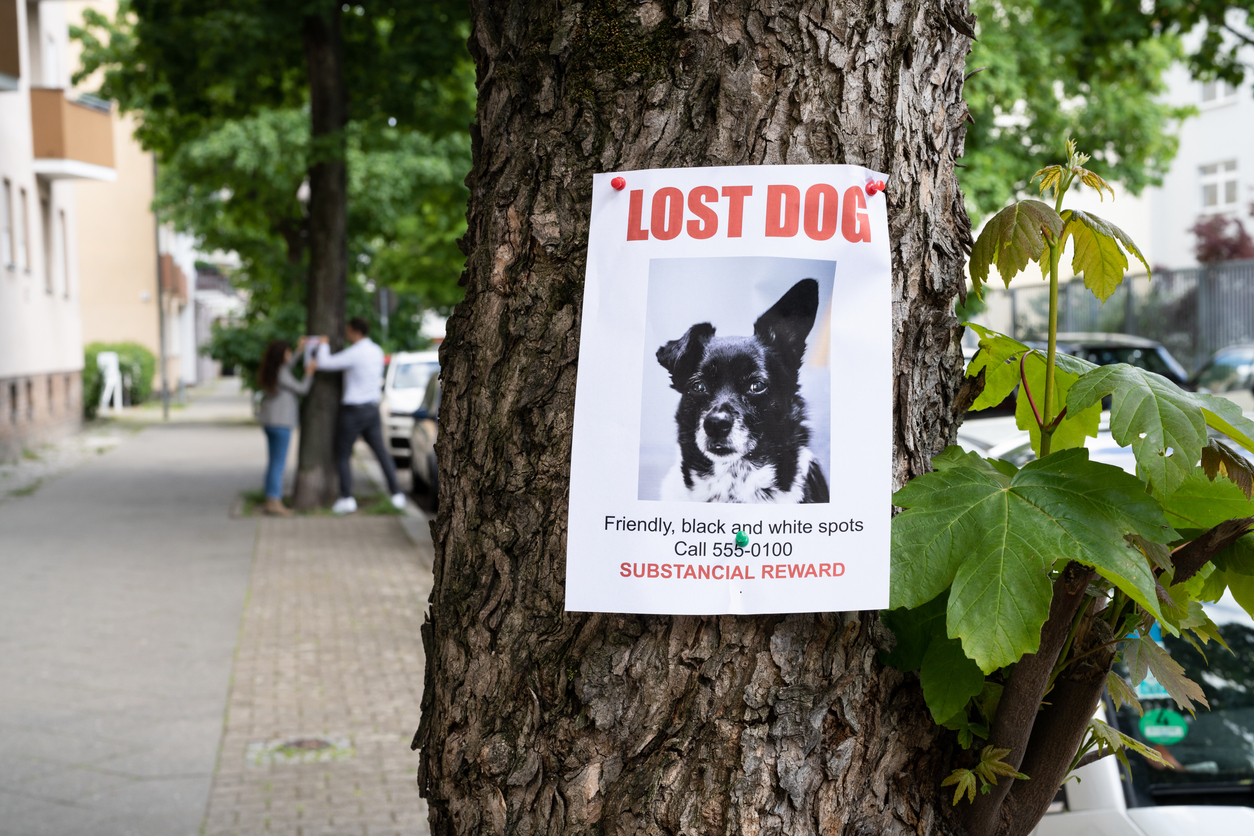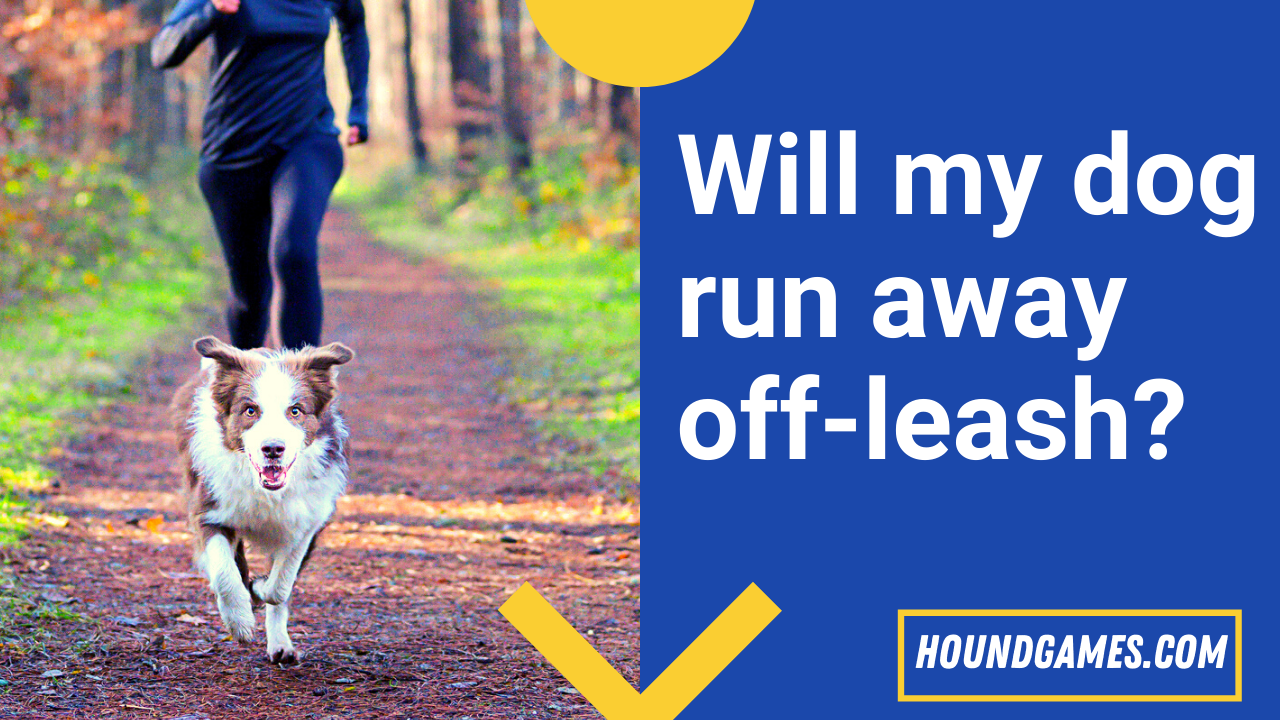Will my dog run off if I let them off their leash? It’s a common concern amongst dog owners, with good reason. Many dog owners are afraid to let their pets off the leash in public areas, like the park or the beach due to the possibility of their dog running away.
Unfortunately, this means that owners miss out on some of the best ways to spend quality time with their dogs while letting them get some fun and stimulating exercise off-leash. So, will your dog run away at the first chance they get and how do you stop them from running away?
Will my dog run away if I take them off of their leash?
If your dog is not properly trained, they will probably make a break for it if they are energetic, excited, or spot something interesting. However, there is an important distinction between ‘running away” and ‘running off.’
For the most part, dogs don’t really run away. It would imply that they are trying to get away from you if they did. Dogs that actually run away are usually extremely frightened by something (such as fireworks), or in cases of adoption, they may be looking for their previous owner.
So more commonly, dogs run off towards something that has caught their attention.
It’s painfully frustrating when one’s otherwise well-behaved pup makes a break for it in a public place and dashes around like a mad thing.
Nonetheless, understanding how our dogs experience the world around them can help us understand and sympathize with why they run off at the first opportunity.
Dogs are acutely aware of the sights, smells, and sounds around them. While humans filter out anything that isn’t immediately important, dogs are engrossed in their senses. They instinctively interact with their surroundings and impulse control is something that has to be taught.
In other words, it’s not a conscious decision, and your dog probably isn’t trying to escape. But if they see or smell something they want to chase, they will, unless they are properly obedience trained. Often an excited dog will also simply run off to explore and play if they are given the chance.
However, just because this is natural dog behavior, it doesn’t mean that the behavior is acceptable. A dog that runs off poses a risk to itself, other animals, and people.
Their instinct to engage their senses is very strong. So strong that professional dog trainers will tell you that even a properly trained dog can sometimes give in to the urge. Therefore, it’s vital to only let your dog off-leash in a safe environment that is preferably enclosed.
Are you interested in reading this: Will My Dog Jump Out of the Car Window?
When a dog runs off: the most common mistake
A huge mistake people make when their dog runs off is to run after them. This can encourage them to keep going, after all, you are following close behind. In most cases, it’s better to turn on your heel and walk in the opposite direction, or even hide behind something. The moment your dog realizes you are missing, they will usually make it a priority to find you.

Do dogs come back when they run away?
Dogs usually do come back if they run away. A dog doesn’t run off because they are running away. At that moment, the urge to engage with something that has caught their attention just gets the better of them. A dog will come back so long as they don’t get lost or have some kind of accident that prevents their return.
If your dog runs away and makes it back to you without serious incident, this is the best-case scenario. Hopefully, that squirrel got away, and your dog doesn’t end up in a fight with other dogs or any serious trouble.
That said, a dog lost in its excitement might run off too far and be at risk of running into traffic, along with a host of other mishaps that can prevent them from coming back to you. Or they might stay away for too long, leading you to believe they aren’t coming back. That brings us to the next important point.
Also be sure to read our relevant post, Lost Dog: How Far Can a Dog Travel When Lost
Why do dogs run away
Dogs may run away for various reasons. Some common causes include fear or anxiety, searching for a mate, boredom, lack of training or socialization, and instinctual desire to explore.
Providing a secure environment, proper training, regular exercise, and giving them the attention they need can all help to prevent dogs from running away. If the behavior persists, consulting a veterinarian or animal behaviorist is a good idea.
What to do if your dog runs away and doesn’t come back
Having a dog run away is one of the most traumatic experiences a dog owner can face. It doesn’t matter if they got away on a walk or escaped the yard; you must keep a clear head and act immediately.
1. Search for your dog
The first and most important thing is to start searching for them immediately. Recruit as many friends and family as you can to help you search. Be sure someone stays home in case your dog finds their way back. One of the best things you can do to help find a missing dog is to invest in a good dog GPS tracker such as this one below.
The reason we suggest the PETFON GPS system is there are no monthly fees, which all the others require. Also, this one gives a live long-distance feed straight to your smartphone.
If your dog has a GPS tracker, start there. Otherwise, start your search at nearby places your dog knows. For example, the local dog park or any location they enjoy should be your first stop. If you have a specific route for walks, search it as well.
Your dog may stick to familiar places as they try and make their way home. If you don’t find them anywhere familiar, start your search from the last place you saw them, covering the immediate area before extending the search outward.
As long as you don’t have other pets that might run away as well, open your yard up and put out food.
2. Report your lost dog
If animal control comes across your dog before you do, they might end up in a local shelter. So make sure to call every possible shelter and kennel within 50 miles of the last place your dog was spotted.
Even if they have not seen your dog, leave your name and phone number along with a description of your dog with every phone call you make.
Next, phone the police and report your dog missing. Just be careful not to make demands, especially ones that the police cannot oblige. The police are unlikely to launch a search for your missing dog, but they can radio it to patrols in the area.
Hopefully, any patrol that spots your dog will inform the station. They can then let you know where your dog was spotted. Do not expect the police to catch your dog; procedure dictates that they leave that to animal control.
Extra tip: If you’re near a train line, then you can also call your city train service number and let them know your dog has run away, as train drivers may have spotted your lost dog and called it in.
3. Post it to social media
Social media and community groups are another great way to increase the number of people on the lookout. For the most part, people will eagerly report any sightings of your dog. However, you can further improve your chances by posting a reward.
The more people you reach with your posts, the more likely someone will report something that can help you track down your dog.
4. Put up posters, hand out flyers
Once the go-to when searching for a lost pet, people underestimate how effective these strategies are. A poster or flyer might just be the way that you reach someone who would otherwise have seen your dog wandering and thought nothing of it.
Posters are particularly effective on popular dog walking routes and at pet-friendly parks. Another effective tactic is having as many people hand the flyers out, door to door, in your neighborhood.

How to train a dog not to run away
It can be difficult to train an adult dog not to run away. However, suppose a dog repeats an action enough times. In that case, it becomes an ingrained behavior, but a dog with a history of running off isn’t going to learn overnight.
For these dogs, it’s best to keep them on a leash and enlist the help of professionals to help teach a reliable recall, as well as training them to sit and stay on command.
The best time to start training is when your dog is still a puppy. Training a completely reliable recall is quite advanced, so you must remain patient and consistent. Remember that a negative experience with training is far worse for a dog than no training at all.
If you are wondering about puppy school versus obedience training, you can read this article here.
And if you want to teach your puppy to stay in one place, you can read this article on place training.
There are a couple of commands that can do the trick, and the two most needed ones are the stay command and the recall command.
To train your pup to follow the recall command, you are going to need a bag of treats and an enthusiastic attitude full of praise.
Step one
You can start by backing away from your puppy when they get distracted and then call their name. The trick is to make yourself as interesting as possible by offering food, toys, waving your arms, or even running away from them.
Praise your puppy heavily and make a huge fuss every time they come to you. If they don’t, don’t go after them. Just walk in the opposite direction. In the beginning, always praise and treat your dog the second they come to you.
Step two
You can begin adding a command to the behavior. It’s vital not to do this while your dog is doing anything else other than coming to you. Avoid a word like “come” as they may have heard this a lot already and may be desensitized to it.
Instead, choose an unusual word they will not hear often from you or other people, and say it clearly while your dog is actively running toward you.
This way you begin to connect the action of running to you with the command word. Do not repeat the word over and over again when the dog is doing something else, as this only teaches them to ignore the word.
Step three
As your dog becomes more and more excited about coming to you and the command word becomes strongly associated with the action of returning, you can start using the command word earlier until it becomes the trigger.
Remember not to desensitize your dog to the word by repeating it over and over again, and reward your dog thoroughly every time they come.
Eventually, you can make rewards more intermittent, to keep your dog interested. You can also quietly withhold a treat if they take too long to come. But, Never punish them for not returning fast enough, as this teaches them that coming to you is a bad thing.
If they do delay on their way to you, and you withhold a treat, try getting them excited and give them another chance to do it faster.
Remember, always set your dog up for success! Sometimes this means going back a few steps, so patience is necessary.
Also, be sure to be the most interesting thing in the environment. Whether it’s your dog’s favorite ball or treat, whatever you have to encourage your dog to come to you needs to be more interesting than anything else.
Do not start training overstimulating environments like dog parks that may have too many distractions.
Step four
As your dog’s recall becomes more reliable you can gradually begin to extend the distance between you or try new environments. Introduce more and more distractions over time so that your dog is conditioned to come to you when you give the command, regardless of how interesting something external may be.
In time you are going to take this trick on the road. But, first, your puppy must learn to react to the command almost instinctively. If they don’t, the command might not override the impulse to run off.
The ‘stay’ command is just as important. Training your dog to stay adds an element of safety because they are meant to stop in their tracks and stay where they are.
Teaching your dog to stay reliably is an involved process. Fortunately, you can check out our article on clicker training, where we discuss training your pup to stay.
Can dogs find their way home?
Yes, dogs can usually find their way home unless they have been physically taken away. That said, there is some dispute about how dogs find their way home. Different sources report different ways that dogs navigate their way home.
There are two leading theories. The more obvious idea is that they use their sense of smell to find their way home. The other is that dogs can sense the earth’s magnetic field and have a built-in ‘compass’ that allows them to find their way home.
Fascinatingly, scientific studies back the latter, with a study published in Frontiers in Zoology documenting the phenomenon.
Why does my dog run away when I open the door?
Also called door-dashing, dogs commonly rush the door for the same reasons they run off on a walk. Excitement, curiosity, and instinct overcome most dogs, which is probably why this is such a common problem. Good obedience training and controlling your dog’s environment can stop dogs from running out the door.
Do dogs run away because they’re unhappy?
It’s tricky to define what being unhappy is to a dog. For example, an abused dog often won’t run away, even if they get the chance. On the other hand, a dog could have all their needs met, live with a loving family, and still make a break for it every chance they get.
Sometimes, the urge to roam is genetic. For instance, Huskies and Chow Chows are notorious escape artists that love getting out of the yard and going on their own adventures.
Close quarter guardians like the Cane Corso and the Neapolitan Mastiff, on the other hand, prefer to stay close to their homes, even if the gate is wide open.
In fact, breed probably plays more of a role in a dog running away than whether or not they are unhappy. The breeds most likely to run away or get lost are Anatolian shepherds, bloodhounds, and the Great Pyrenees.
If you own a German Shorthaired Pointer, then be sure to read our post German Shorthaired Pointer (GSP) Running Away
Furthermore, boredom, anxiety, and pent-up energy are responsible for many more cases than abuse or neglect.
Summary
For the most part, dogs don’t run away from home or their owner. Instead, they run towards something that has piqued their interest or they just run to burn off energy or explore a new environment. Dogs certainly don’t dart off to spite their owners, and they usually return after a bit.
If your dog runs away, keep calm, start a search in your area, phone the local shelters, and report it to the police. Social media and flyers are a great way to extend the reach of your search.
Naturally, prevention is better than cure, and training your puppy from an early age can help avoid the problem. That said, even well-trained dogs will make the occasional dash.
It’s not necessarily because they are unhappy. Instead, boredom, breed, and pent-up energy are the likely culprits when a dog runs away from home.





